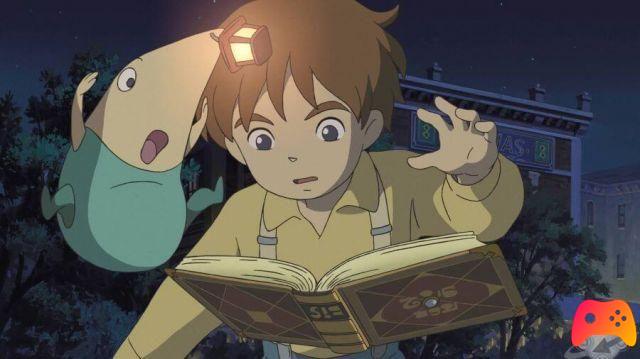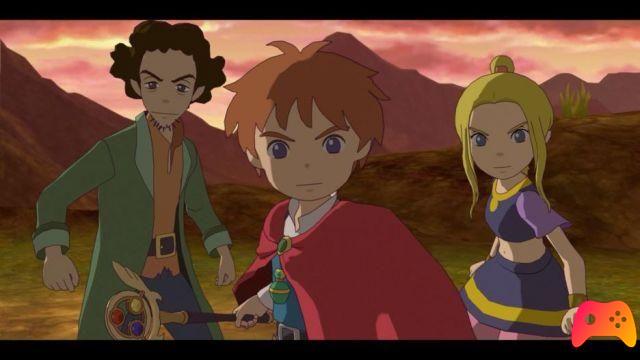
Review for Ni no Kuni: Wrath of the White Witch Remastered. Game for PC and PlayStation 4, the video game was released on 20/09/2019
A decade ago Ni no Kuni had attracted the attention of all the JRPGists, happy to finally see a project of some weight on home consoles: the last generation, in fact, turned out to be rather poor in this regard due to the excessive power of Nintendo DS and PSP. Even Ni no Kuni, in fact, was born on the Nintendo laptop.
Eventually, the Level 5 game also arrived in the West, in 2013, and proved to be a success, to the point of originating a saga. Now Bandai Namco Entertainment offers us the game in a remastered version, trivially called Ni no Kuni Remastered, on PlayStation 4 and PC.
"Ni no Kuni" roughly means "second world". The idea behind the events is in fact the following: in addition to ours, there are also other dimensions. Lucciconio, King of the Fairies, comes from one of these, closely linked to our planet. Indeed, every soul finds its double in the parallel world, as if it were a Hyperuranium. The only way to travel from one dimension to another is through magic. The main character is Oliver, a child able to save the two worlds, according to an ancient prophecy; he comes soon initiated into the magical arts from Lucciconio, so that you can go "to the other side" and become a Sage capable of defeating the dark forces. And to save his mother, who died on Earth, through her soul mate.
La plot it's so classical to make us think of Ni no Kuni as a "video story", which benefits from one of the most magical artistic directions of all, thanks to involvement of Studio Ghibli. The greatest suggestions are precisely visual, rather than narrative. This does not mean that Hino's work is to be despised (even if at the end ..., Ed): the owner of Level-5 was attentive and tried to trace some of the main themes of the works of the famous Japanese animation studio. On the other hand, perhaps even Studio Ghibli would not have done better, given the structural difference between a film and a JRPG. What matters at this point is the involvement, ensured by a wonderful world and a well-assembled group of protagonists. Lucciconio, our mentor, is one of the funniest characters: funny, with a joke always ready, he expresses himself with a 'inflection in translation, with a choice that brings to mind Final Fantasy IX. It is a way to make the speech particular, as in fact results from the dubbing (English, well done, or Japanese can be selected); some will love it, others will hate it. In the opinion of this writer, it is not so terrible.

The structure of Ni no Kuni is that of Classic JRPG, characterized by one linear development, From world map, from the solution of continuity between exploration and clashes, which, however, are not random, and from a hybrid battle system, which is halfway between the turns and the action.
The game world (the one "beyond": sessions on Earth do not have the same weight on the global gameplay economy) it's wonderful: cities, sufficiently articulated dungeons, deserts, vast plains, seas to sail ... Ni No Kuni brings to mind the carefree hours spent in childhood / youth to unearth the secrets of the old Final Fantasy, thanks to a world map with a moving beauty. In the past generation few JRPGs have taken advantage of this system, and it has been missed; Well, not only did Level-5 restore dignity to the world map, but it also conjugated it with visible monsters and with the art of Studio Ghibli, supported by a graphics engine in fine cel shading. The same goes for cities and dungeons, which are inspired by the usual stereotypes in principle, but reread them with skill, making each new screen a pleasant discovery.

This version remastered, made by QLOC, turns a 1080p to 60 fps on PlayStation 4, while on PlayStation 4 Pro it is possible to choose between coupled 4k for 30 fps and 1440p for 60 fps; on PC, however, both frame rate and resolution will be unlocked. The Switch version, on the other hand, is a mere port of the original PlayStation 3 version, so it runs at 720p for 30 fps. For the rest, the remaster does not touch anything else, but there was really no need: the game at the time was phenomenal and has aged very well, as often happens with cel-shaded games, which have the advantage (for so to speak) to never pursue photorealism.
Our wanderings are accompanied by one top notch soundtrack, thanks to the involvement of Joe hisaishi (aka Mamoru Fujisawa), which Studio Ghibli fans should know quite well: Nausicaa in the Valley of the Wind, My Neighbor Totoro, Laputa, Princess Mononoke and much more have been “set to music” by him. The pieces were performed byTokyo Philharmonic Orchestra.

As already mentioned, the battle system is characterized by a hybrid nature, "Action but not too much". The player commands a party member directly, with absolute freedom of movement within the battlefield, but the moves must still be selected from a menu; then a clock icon appears at the bottom left, indicating the period during which the fighter cannot make another move (however, it is possible to "cancel" some commands, such as physical attack or defense), a a bit as if shifts were marked. It must also be said that not everything happens in real time.
The big problem with action or pseudo systems is that the player can only control one ally, so the others are entrusted to the AI (Tales of also allows local multiplayer), which in Ni no Kuni is not exactly the best. Unfortunately, the ample customization possibilities that we find in titles such as the aforementioned Tales of are also missing, which are more complex and satisfying from this point of view. The problem is mitigated in part by the possibility to switch characters at any time and from a not prohibitive difficulty (and it is possible to change the degree of challenge at any time), but there is no doubt that a more refined management system would certainly have made the battles more pleasant.

A leading role in the fighting is played by familiars, curious creatures to capture and train. Each ally can keep three of them and can summon one at a time for a limited amount of time. Each familiar is equipped with particular moves, equipment, characteristics and parameters, with the exception of HP and MP, which are those of its “trainer”, to use a term used in the Pokémon context; like Nintendo's monsters, pets can evolve, increasing their powers, but returning to level 1.
This monster taming element is well integrated into the game and confers a broad spectrum of tactical solutions, which would be precluded if we were to limit ourselves to the small number of allies. A bit annoying is the question of capture: to secure the services of a familiar it is (usually) necessary to defeat it in a duel and then serenade it (!) When hearts appear above its head. The problem is that these damn little hearts don't always appear, making the system absolutely random. Not a big deal, but definitely a nuisance when secondary assignments require the capture of certain monsters ...

Ni no Kuni is vast, and it can become even more so for completists. The main quest runs around the typical forty hours, calculated without rushare, but without even dwelling on everything. In the latter case, the time required will increase considerably, given the huge number (about 130) by subquest, some of which to play in the post game. They are basically divided into two categories: monster hunts and requests for help. By completing these tasks, you earn points that can be spent on interesting bonuses, such as lowering prices in shops or increasing the speed of travel / cruise in the world map. These rewards are far more interesting than the tasks in itself, which in the long run reveal themselves repetitive: to keep silent about the hunts, even the aid to citizens does not foresee big variations, almost always manifesting itself in fetch quest (go and get a flower that grows in a forest, recover a page of my diary, bring me these familiars, etc.); even worse, the contributions to the plot and to the characterization of the characters are almost nil.
In addition to these “canonized” side quests, there are also other factors that increase longevity, such as the search for hidden treasures or all races of familiars, Horatio's puzzles and a fairly classic crafting system, based on recipes. However, this remastered version hasn't added any content, not even secondary ones.

Ni no Kuni Remastered is an excellent opportunity to enjoy a great last generation JRPG to the fullest, but the absence of any news, together with an excessive launch price, should dissuade those who have already faced the game on PlayStation from buying. 3.
► Ni no Kuni: Wrath of the White Witch Remastered is a JRPG type game developed by Level 5 and published by Bandai Namco for PC and PlayStation 4, the video game was released on 20/09/2019






